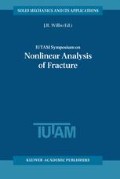Abstract
Laminated composites exhibit non-linear stress-strain behaviour because of the initiation and growth of arrays of cracks in the plies of laminates leading to stress transfer between cracked and uncracked plies and to consequential changes in the effective thermoelastic constants of laminates. Recent progress with the development of stress-transfer models for transverse cracking in simple cross-ply and multiple-ply laminated cross-ply composites is described. The equilibrium equations, the out-of-plane stress-strain relations and the interface conditions (assuming perfect bonding) together with boundary conditions involving stresses, are satisfied exactly. The remaining in-plane stress-strain relations and boundary conditions involving displacements are satisfied on averaging through the thickness of each ply. The model is based upon a single assumption and the predicted stress and displacement fields lead to stationary values of the Reissner energy functional. The generalised in-plane strain model of stress transfer, when coupled with ply refinement methods, offers a powerful technique for predicting accurately both stress and displacement distributions, and the effective thermoelastic constants of cracked laminates.
It is also shown how solutions may be used with energy balance methods to predict simple relations governing the initiation and growth of ply cracking, and non-linear stress-strain behaviour. While the model is formulated at the ply level the criteria governing the formation of cracks in transverse plies are such that they involve only parameters that can be defined at the macroscopic laminate level, e.g. the effective thermoelastic constants of the cracked laminate, crack closure stresses and the energy absorbed in the laminate by ply crack formation. Thus the use of a high quality stress-transfer model leads to the construction of a bridge between a model formulated at the ply level, and the macroscopic behaviour of multiple-ply laminates containing arrays of transverse cracks.
Access this chapter
Tax calculation will be finalised at checkout
Purchases are for personal use only
Preview
Unable to display preview. Download preview PDF.
References
Hashin, Z., Mech. of Mater. 4, (1985), pp. 121–136.
Hashin, Z., Eng. Fract. Mech. 25, (1986), pp. 771–778.
Hashin, Z., J. Appl. Mech. 54, (1987), pp. 872–879.
Hashin, Z., Comp. Sci. Tech. 31, (1988) pp. 247–260.
Nairn, J.A., J. Comp. Mater. 23, (1989), pp. 1106–1129.
Nairn, J.A., Eng. Fract. Mech. 41, (1992), pp. 203–221.
Nairn, J.A., ‘Some new variational mechanics results on composite microcracking’, Proc. 10th Int. Conf. on Composite Materials, Whistler, B.C. Canada, Aug. pp. 14–18, 1995.
McCartney, L.N., J. Mech. Phys. Solids, 40, (1992), pp. 27–68.
McCartney, L.N., ‘A recursive method of calculating stress transfer in multiple-ply cross-ply laminates subject to biaxial loading’, NPL Report DMM(A)150, January 1995.
McCartney, L.N., Hannaby, S. and Cooper, P.M., Proc. of 3rd Int. Conf. on Deformation and Fracture of Composites, University of Surrey, 27–29 March 1995, pp. 56–65.
Hannaby, S.A., ‘The solution of ordinary differential equations arising from stress transfer mechanics’ NPL Report DITC 223/93, November 1993.
McCartney, L.N., Composites, 24, (1993), pp. 84–92.
McCartney, L.N., ‘The prediction of non-uniform cracking in biaxially loaded cross-ply laminates’, NPL Report DMM(A)142, July 1994.
McCartney, L.N., “Prediction of microcracking in composite materials”, in “FRACTURE: A Topical Encyclopaedia of Current Knowledge Dedicated to Alan Arnold Griffith”, pp. 905–916, (ed. G.P.Cherepanov ), Krieger Publishing Company, Melbourne, USA, 1995.
Author information
Authors and Affiliations
Editor information
Editors and Affiliations
Rights and permissions
Copyright information
© 1997 Springer Science+Business Media Dordrecht
About this paper
Cite this paper
McCartney, L.N. (1997). Predicting Non-Linear Behaviour in Multiple-Ply Cross-Ply Laminates Resulting from Micro-Cracking. In: Willis, J.R. (eds) IUTAM Symposium on Nonlinear Analysis of Fracture. Solid Mechanics and its Applications, vol 49. Springer, Dordrecht. https://doi.org/10.1007/978-94-011-5642-4_35
Download citation
DOI: https://doi.org/10.1007/978-94-011-5642-4_35
Publisher Name: Springer, Dordrecht
Print ISBN: 978-94-010-6379-1
Online ISBN: 978-94-011-5642-4
eBook Packages: Springer Book Archive

